Notebook Trio: ASUS A8JS and G2P and ABS Mayhem Z5
by Jarred Walton on December 29, 2006 12:15 PM EST- Posted in
- Laptops
ASUS G2P - Exterior and Features
We received the ASUS A8JS first, and after our initial experience with it (and experiences with previous ASUS laptops), we had high expectations for the ASUS G2P. The G2P is part of ASUS' gaming laptop series - or their Personal Entertainment Center group - but having looked at the features and specifications of the other laptops in this line (the G1, G2P, G2Pb, and G2Pc) we would have to say that most of these do not really fit the requirements of a "gaming" notebook. They all feature Core 2 Duo processors and a reasonable selection of midrange components.
The problem is, as mentioned previously, that they all come with underpowered graphics chips. Well, perhaps not all - the G1 comes with a GeForce Go 7700, just like the A8JS, although it also comes with a 15.4" LCD with either a 1280x800 or a 1680x1050 native resolution. All of the G2P models on the other hand come with a 17" 1440x900 LCD and a Radeon Mobility X1700 graphics chip. Looking at the specs, the Mobility X1700 probably looks pretty similar to the Go 7700, but in practice it is significantly slower.
We're getting ahead of ourselves though, so let's talk a little bit about the laptop itself. Current prices on the G2P are around $1900, which is a bit more than the A8JS. You do get a larger 160GB hard drive, however, as well as 2GB of RAM standard on all G2P models. The price isn't an excellent bargain, but it isn't that bad either. Similar configurations from other manufacturers end up costing roughly $1800-$2000 as well, although the ability to customize your component selections might make the alternatives more attractive overall. The HP dv9000t for example offers very similar features (when upgraded) for about the same price.
Upon booting up the laptop you are greeted with a red and white logo accompanied by a gong noise and a subtitle proclaiming "ASUS Gaming Series". (The BIOS does allow you the option to disable the startup noise.) The exterior also gives the impression that this might actually be a gaming centric notebook, with red highlights in various locations, a glowing logo beneath the trackpad, and an interesting crosshatched "carbon fiber" pattern in the plastic around the keyboard as well as on the surface of the trackpad. The top of the laptop appears to be made of aluminum with a hard plastic coating to help resist scratching. Strictly in terms of appearance, the ASUS G2P impresses, and there are other good aspects as well.
One of the highlights of the laptop is definitely the LCD, which is easily the brightest and most vibrant laptop LCD we have used to date. The response time figure of 8 ms might be mostly marketing, but there's no denying the fact that this display looks better than the other displays in this notebook roundup. Given that we didn't have any difficulties using the other displays for a large variety of tasks, it's not too surprising that the G2P LCD worked without problems for everything we threw at it. Still, there is definitely a noticeable difference in viewing angle, brightness, contrast, and overall quality that can easily be seen with the naked eye. We would like to see this type of display on more notebooks, with one caveat: for a 17" laptop, we would really prefer to see 1680x1050 resolution at a minimum. Perhaps the lower maximum resolution somehow helps with the other improved characteristics, or it may simply be that this is one of the first of a new series of laptop LCDs and we will begin seeing improvements with higher resolution displays in the near future. The brightness does come at the expense of battery life, unfortunately, but you can always turn down the brightness when going mobile. (Maximum brightness in battery mode is also slightly dimmer than in AC mode.)
Moving on from the display, let's take a quick look at the various ports and expansion options offered. Starting with the front of the unit, there are no ports, and the only buttons visible from the exterior are the front latch button along with some multimedia buttons. Just underneath the latch are five buttons that can be used for controlling media playback. The five buttons going left to right provide access to power, previous track, next track, stop, and play/pause functions. The power button will start Windows, but it does not cause Windows to shut down. It also causes the laptop to boot with a slightly different logo screen and without the gong noise (for no apparent reason). These keys work with various media players as expected. LED indicators for power, battery, email, and WiFi are visible to the right of the five multimedia buttons.
The right side of the A8JS is where the optical drive resides, and the only other item present on the right is the power adapter socket. There seems to be a lot of wasted space on the first two edges, and we certainly wouldn't have minded seeing at least a few USB ports on the right side.
The left side of the laptop is where the vast majority of the connections are located. There's one USB port, an unpowered FireWire port, three audio jacks allowing for 5.1 analog speaker connections, and a headphone jack can also function as an optical S/PDIF output. Network and modem ports are available towards the rear of the laptop, while the front has a flash memory socket supporting MMC, SD, and MS/MS Pro. Below the flash slot is the ExpressCard 54 expansion slot. There's also a switch to turn the WiFi connection on or off and an infrared interface at the very front. Between the USB port and audio jacks are a couple of less common options for laptops. The thin port is for external SATA hard drives, while the round socket is the input for the integrated TV tuner.
Finishing up with the rear of the unit and starting on the left, the first thing we see is the heat exhaust port. The intake ports are located on the bottom of the laptop, but this is the only exhaust. Given that this laptop is larger than the G2P and also features a less powerful graphics chip, the laptop doesn't get nearly as hot. Next to the exhaust is a security locking mechanism, followed by a TV output connector. The TV connector supports S-Video, component, and composite output. VGA and DVI ports are next, and once again the DVI port does not support dual-link DVI. Finally, at the far right are four USB ports.
Opening up the unit, you can see the crosshatched pattern we were talking about earlier surrounding the keyboard. It looks pretty cool, but otherwise doesn't really serve any purpose. There's also a logo beneath the trackpad that is their purely for appearance, and it glows red when the system is turned on. (This same logo is displayed during the POST sequence.) To the top-left of the keyboard is a small LED display that normally lights up and reads ASUS; we don't know whether or not this display can be programmed to show other information. We've already talked about the display, which is really great, and just below the display are five more buttons: search, email, Internet, trackpad on/off, and the power button. Once again above the display is a webcam and microphone, only this time the webcam is a 1.3 megapixel model. During testing we found it provided a slightly better picture quality than the 0.3 megapixel model on the A8JS, although with four times as many pixels it certainly didn't appear four times as good. However, using Windows Movie Maker we were unable to capture video at a resolution higher than 720x576, which was likely a limitation of the software rather than the camera.
Taking a quick look at the keyboard, the layout is nearly identical to that of the keyboard on the A8JS. (We were apparently sent a European version, so the US version may be identical to the A8JS - which would be preferable, as the location of a few keys did cause confusion at times.) The problem is, with a much larger 17" chassis we really expect to see a number keypad on an optimally configured laptop. Rather than using a wider keyboard area, ASUS puts red decorative ventilation to the left and right of the keyboard. We say "decorative" as we couldn't tell that it was actually used for that purpose, and we're pretty sure it's not used for audio either as the speakers are located on the bottom front of the laptop. Such a layout does keep the keyboard centered relative to the display, but we still would have liked to see a number keypad instead. You can also see the red lettering on the WASD keys, once again helping to give the laptop the appearance of being suitable for gaming.
We received the ASUS A8JS first, and after our initial experience with it (and experiences with previous ASUS laptops), we had high expectations for the ASUS G2P. The G2P is part of ASUS' gaming laptop series - or their Personal Entertainment Center group - but having looked at the features and specifications of the other laptops in this line (the G1, G2P, G2Pb, and G2Pc) we would have to say that most of these do not really fit the requirements of a "gaming" notebook. They all feature Core 2 Duo processors and a reasonable selection of midrange components.
The problem is, as mentioned previously, that they all come with underpowered graphics chips. Well, perhaps not all - the G1 comes with a GeForce Go 7700, just like the A8JS, although it also comes with a 15.4" LCD with either a 1280x800 or a 1680x1050 native resolution. All of the G2P models on the other hand come with a 17" 1440x900 LCD and a Radeon Mobility X1700 graphics chip. Looking at the specs, the Mobility X1700 probably looks pretty similar to the Go 7700, but in practice it is significantly slower.
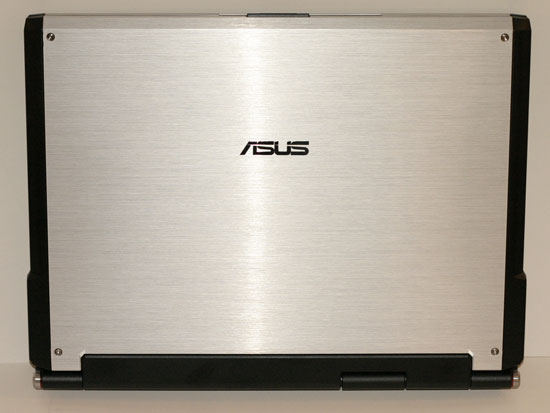 |
| Click to enlarge |
We're getting ahead of ourselves though, so let's talk a little bit about the laptop itself. Current prices on the G2P are around $1900, which is a bit more than the A8JS. You do get a larger 160GB hard drive, however, as well as 2GB of RAM standard on all G2P models. The price isn't an excellent bargain, but it isn't that bad either. Similar configurations from other manufacturers end up costing roughly $1800-$2000 as well, although the ability to customize your component selections might make the alternatives more attractive overall. The HP dv9000t for example offers very similar features (when upgraded) for about the same price.
Upon booting up the laptop you are greeted with a red and white logo accompanied by a gong noise and a subtitle proclaiming "ASUS Gaming Series". (The BIOS does allow you the option to disable the startup noise.) The exterior also gives the impression that this might actually be a gaming centric notebook, with red highlights in various locations, a glowing logo beneath the trackpad, and an interesting crosshatched "carbon fiber" pattern in the plastic around the keyboard as well as on the surface of the trackpad. The top of the laptop appears to be made of aluminum with a hard plastic coating to help resist scratching. Strictly in terms of appearance, the ASUS G2P impresses, and there are other good aspects as well.
One of the highlights of the laptop is definitely the LCD, which is easily the brightest and most vibrant laptop LCD we have used to date. The response time figure of 8 ms might be mostly marketing, but there's no denying the fact that this display looks better than the other displays in this notebook roundup. Given that we didn't have any difficulties using the other displays for a large variety of tasks, it's not too surprising that the G2P LCD worked without problems for everything we threw at it. Still, there is definitely a noticeable difference in viewing angle, brightness, contrast, and overall quality that can easily be seen with the naked eye. We would like to see this type of display on more notebooks, with one caveat: for a 17" laptop, we would really prefer to see 1680x1050 resolution at a minimum. Perhaps the lower maximum resolution somehow helps with the other improved characteristics, or it may simply be that this is one of the first of a new series of laptop LCDs and we will begin seeing improvements with higher resolution displays in the near future. The brightness does come at the expense of battery life, unfortunately, but you can always turn down the brightness when going mobile. (Maximum brightness in battery mode is also slightly dimmer than in AC mode.)
 |
| Click to enlarge |
Moving on from the display, let's take a quick look at the various ports and expansion options offered. Starting with the front of the unit, there are no ports, and the only buttons visible from the exterior are the front latch button along with some multimedia buttons. Just underneath the latch are five buttons that can be used for controlling media playback. The five buttons going left to right provide access to power, previous track, next track, stop, and play/pause functions. The power button will start Windows, but it does not cause Windows to shut down. It also causes the laptop to boot with a slightly different logo screen and without the gong noise (for no apparent reason). These keys work with various media players as expected. LED indicators for power, battery, email, and WiFi are visible to the right of the five multimedia buttons.
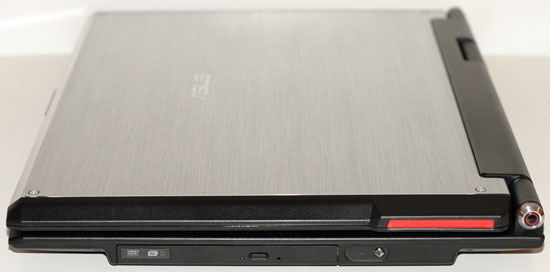 |
| Click to enlarge |
The right side of the A8JS is where the optical drive resides, and the only other item present on the right is the power adapter socket. There seems to be a lot of wasted space on the first two edges, and we certainly wouldn't have minded seeing at least a few USB ports on the right side.
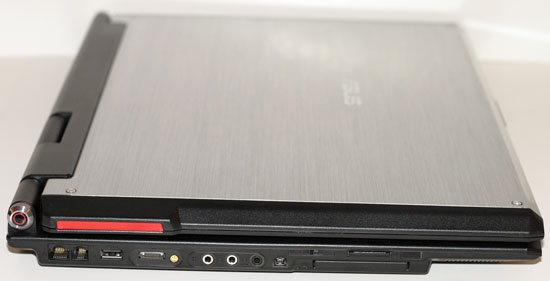 |
| Click to enlarge |
The left side of the laptop is where the vast majority of the connections are located. There's one USB port, an unpowered FireWire port, three audio jacks allowing for 5.1 analog speaker connections, and a headphone jack can also function as an optical S/PDIF output. Network and modem ports are available towards the rear of the laptop, while the front has a flash memory socket supporting MMC, SD, and MS/MS Pro. Below the flash slot is the ExpressCard 54 expansion slot. There's also a switch to turn the WiFi connection on or off and an infrared interface at the very front. Between the USB port and audio jacks are a couple of less common options for laptops. The thin port is for external SATA hard drives, while the round socket is the input for the integrated TV tuner.
 |
| Click to enlarge |
Finishing up with the rear of the unit and starting on the left, the first thing we see is the heat exhaust port. The intake ports are located on the bottom of the laptop, but this is the only exhaust. Given that this laptop is larger than the G2P and also features a less powerful graphics chip, the laptop doesn't get nearly as hot. Next to the exhaust is a security locking mechanism, followed by a TV output connector. The TV connector supports S-Video, component, and composite output. VGA and DVI ports are next, and once again the DVI port does not support dual-link DVI. Finally, at the far right are four USB ports.
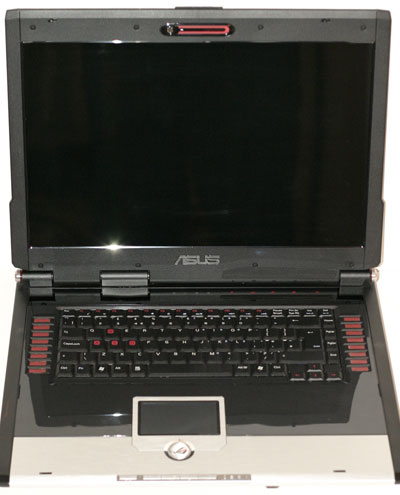 |
| Click to enlarge |
Opening up the unit, you can see the crosshatched pattern we were talking about earlier surrounding the keyboard. It looks pretty cool, but otherwise doesn't really serve any purpose. There's also a logo beneath the trackpad that is their purely for appearance, and it glows red when the system is turned on. (This same logo is displayed during the POST sequence.) To the top-left of the keyboard is a small LED display that normally lights up and reads ASUS; we don't know whether or not this display can be programmed to show other information. We've already talked about the display, which is really great, and just below the display are five more buttons: search, email, Internet, trackpad on/off, and the power button. Once again above the display is a webcam and microphone, only this time the webcam is a 1.3 megapixel model. During testing we found it provided a slightly better picture quality than the 0.3 megapixel model on the A8JS, although with four times as many pixels it certainly didn't appear four times as good. However, using Windows Movie Maker we were unable to capture video at a resolution higher than 720x576, which was likely a limitation of the software rather than the camera.
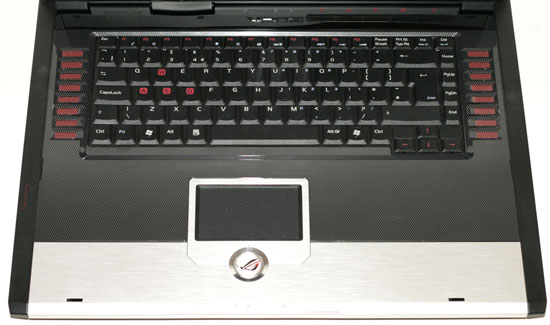 |
| Click to enlarge |
Taking a quick look at the keyboard, the layout is nearly identical to that of the keyboard on the A8JS. (We were apparently sent a European version, so the US version may be identical to the A8JS - which would be preferable, as the location of a few keys did cause confusion at times.) The problem is, with a much larger 17" chassis we really expect to see a number keypad on an optimally configured laptop. Rather than using a wider keyboard area, ASUS puts red decorative ventilation to the left and right of the keyboard. We say "decorative" as we couldn't tell that it was actually used for that purpose, and we're pretty sure it's not used for audio either as the speakers are located on the bottom front of the laptop. Such a layout does keep the keyboard centered relative to the display, but we still would have liked to see a number keypad instead. You can also see the red lettering on the WASD keys, once again helping to give the laptop the appearance of being suitable for gaming.










17 Comments
View All Comments
unclebud - Saturday, December 30, 2006 - link
"Seems all the usual suspects are on a holiday"more than likely they were just thrown speechless by such extreme bias in this "review"...
newsflash - it can have a sorry gma 900 in it that can barely play rollercoaster tycoon and call it a "gaming laptop" if they want...
ugh. i tried skipping around to get something valuable out of this "article", but there aren't any pictures of the models even...
going to reread mr anand's review of his laptop to cheer myself up -- now that's a thorough review!
JarredWalton - Saturday, December 30, 2006 - link
"but there aren't any pictures of the models even"Umm... what? There are 36 images (with enlarged shots) in the article, plus another 30 or so graphs/charts. If you're not seeing them, either your browser is incorrectly configured and is blocking the images, or else the servers are having issues. And if someone called a GMA900 a "gaming notebook" they would be lying; calling an X1700 laptop a gaming laptop is more of an exaggeration, but it's clearly not the fastest mobile GPU.
I honestly have no idea what you mean by bias, so I'd be happy if you would point out areas that are "biased" rather than just giving a blanket label to the article.
mino - Friday, December 29, 2006 - link
Overall a nice review, those ASU are getting some serious popularity here in Europe while the reviews are nowhere to find..However, ranting for half a page about 14inch not having numeric keypad? I would have thought it was under you level of knowledge...
While the KB is NOT perfect in any sense - small enter, small keys.. - the absence of numeric keypad is natural.
Maybe you should spend a few weeks on road with some 17inch baby of yours to see how "important" numeric keypad really is...
One thing I hate about A8J is that transreflective (CrystalSomething) screen. It is pretty much unusable the moment the sun shines, and it does shine a bit too much in the summer.
JarredWalton - Friday, December 29, 2006 - link
I wasn't really complaining about the lack of a numpad on the 14" A8Js, merely pointing out that it's not there and you really can't fit one into such a chassis. My "rant" for half a paragraph was dedicated to the Fn key - and mostly I was just talking about the uses and making a minor complaint about it not being switched with the Ctrl key location. Unless you're looking somewhere else?I tried to discuss my feelings about the keyboards on each laptop, as that's pretty important with long-term use. Given what I do for a living (writing), I would actually avoid purchasing the G2P (as tested) and the Mayhem Z5 purely on the basis of the keyboard alone. The US G2P might actually be fine, as the primary issue I had was with the mixed up locations (relative to most keyboards) of the \ and " keys.
As for the G2P, that's where I complained about the missing numpad, and it's a 17" model notebook. I complained about this same issue on the Dell XPS M1710 and E1705, as I use numpads on a regular basis and find them to be important. Ironically, the ABS includes a numpad, which I liked, but the other missing keys (Home - PgDn) were at least as irritating to me as the lack of a numpad. Obviously, my taste in keyboards isn't the same as every other person's, which I why I started the article talking about the importance of trying out laptops in person where possible - or try a similar laptop if that's all you can do.
Ideally, I'd like a 17" notebook to have a numpad and a layout very much like the ABS, only shrink the width of the Backspace, \, Enter, and Shift keys and put in a column with Home, End, PgUp, and PgDn similar to how the two ASUS laptops do it. There's plenty of room there for those keys... or just extend the keyboard area down a bit and put the keys right above the cursors like on a regular keyboard.
As for the two ASUS laptop LCDs, I didn't find the LCD on the G2P to have problems in bright light (sunlight is a stretch but possible). Hopefully all newer ASUS laptops have LCDs more like the G2P. The A8J on the other hand is definitely the worst LCD of the bunch and really suitable for indoor use only (or on overcast days). When I first used it I didn't think too much about the LCD quality, as most laptop LCDs can't compete with desktop LCDs in terms of brightness and color quality. After playing with the other notebooks, however, I became quite unhappy with the A8J LCD. Sure, it helps battery life, but all you need to do is have more brightness levels to allow for lowered battery use on LCDs like the G2P.
mino - Saturday, December 30, 2006 - link
Seems all the usuall suspect are on a holiday :)Maybe I should read a bit more thoroughy, and sllep more too :). Point taken.
As for the display, the are two things. I am yet to see an glossy surface LCD to be usable on sunlight. They are nice and sharp for movies and indoors. But my observation is that the moment sun shines (also through an unprotected window) the display changes to a mirror - well, it called an "mirror effect" dispaly sometimes :). At the same conditionas even a poor-quality anti-glare one retains usability.
That said I will have to pass the A8J, otherwise it is pretty solid bundle(I like the BT+DVI+14"WXGA+ combo).
Should the time come when the notebook are regularly of built-to-order variety such is it with cars now. That way most of these "issues" with manufacturer isung bad display, VGA, CPU and so on would be a thing of the past.
It would not even increase the price too much provided good automation is employed. Actually this would greatly simplify the abundance of notebook based of the same chassis with a bit different internals only.
Hell, just ASUS has 5+ series with the same 15.4inch chassis...
mino - Saturday, December 30, 2006 - link
spelling, here you come :(francisco54 - Friday, May 16, 2014 - link
hola mepodeia mamdar los draivers de este ordenador